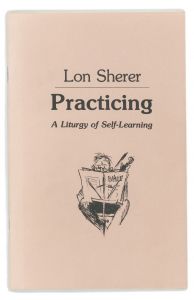Musician’s guide to learning still resonates 25 years later

GOSHEN, Ind. – A 35-page book that urges music students to become “better ‘practicers’ and learners” and to regard such time as a vital personal liturgy continues to be the top-selling Pinchpenny Press book, nearly 25 years after its publication.
The book, Practicing: A Liturgy of Self-Learning, by Lon Sherer, a professor emeritus of music at Goshen College, sits in first place on the Pinchpenny best-seller list, with 2,082 copies having been sold. Pinchpenny is a Goshen College press for chapbook-size books written by students, faculty members or friends of the college, and is managed by the English Department. The press has published 220 titles since its inception in 1969.
In 1975, as Sherer notes in the foreword to the book, after nearly 20 years of teaching, conducting and performing as a violinist, he underwent surgery to remove an acoustic tumor. The surgery in California saved his life, but left him without hearing in the right ear and with a partial loss of muscle and nerve control on the right side. He returned home to Goshen, a violinist who could no longer play the violin.
“After my surgery, my most challenging tasks involved re-learning both basic and advanced bowing techniques that I was no longer able to do because of paralysis on my right side,” Sherer said. “I needed to master these techniques, one at a time—using different sets of muscles and nerves that still worked.
“In the process I began to realize that confronting my actual learning the second time around was a rare gift that illuminated areas of learning in countless and often vivid ways,” he said. “The re-learning changed my approach to the instrument and changed my teaching, and I decided to share some of the experience in a talk I gave to the Georgia chapter of the Music Teachers National Association.”
He expanded the talk into a magazine article published first by the American Music Teacher, and soon after by the Emerson Flute Journal. The Pinchpenny book is a further expansion of the article. Pinchpenny Press sells Practicing for $4 a copy. The brown cover presents a modest appearance, with a simple title atop art professor Ezra Hershberger’s sketch of a violinist seated before his music stand.
Sherer, who said he has been “surprised that it has sold well for so long,” credited Kenneth Warren & Son, violin dealers in Chicago, and Shar Products, a world leader in mail-order music materials, for having driven sales. James Warren, who represents the third generation of family ownership of the one of the oldest violin dealerships in the nation, said they have sold more than 200 copies over the years (copies remain in stock, selling for $5).
“Buyers have been from a wide variety but probably in the main teachers who buy it, read it and recommend it to all of their students,” Warren said. “On more than several occasions they have been bought in lots by a teacher and given to their students as Christmas gifts.”
Over the years, Sherer has received accolades from some of the most esteemed musicians in the country.
Nelita True, who debuted with the Chicago Symphony at 17 and went on to become a professor of piano at the Eastman School of Music at the University of Rochester, paid tribute to the chapbook in a letter that she wrote in 1992: “Lon, your book is a treasure from which I will no doubt quote – with full attribution, of course! It so clearly represents a distillation of what appears to be a lifetime of serious reflection. I found many things I hadn’t thought of, but which instantly seem so ‘right.’ Practicing as liturgy alters my view of this regimen in a fundamental way … I love your attitude toward, and your joy for, the ‘richness in the journey.’ ”
In 1987, György Sebők, a pianist and distinguished professor of music at the Indiana University School of Music, read the article on which the book was based. He wrote: “First of all, I want to congratulate you on your article about practicing. I have seldom read a text as illuminating and meaningful as your article.”
That same year, during a sabbatical, Sherer and his wife, Kathryn, who was an assistant professor of music at the college, attended Sebők’s master class in Emen, Switzerland. On the first day, Sebők asked Lon to speak to the class, drawing on lessons from the book.
Later in the sabbatical year, Sherer visited the Menuhin School in Stoke d’Abernon, south of London, where Peter Norris served as the headmaster. Shortly afterward, the great violinist himself, Yehudi Menuhin, wrote: “Mr. Peter Morris gave me your excellent booklet on practicing with its kind inscription. There are many points of particular interest that are enlightening. I thought especially the ‘10,000 times indeed’ was excellent.”
Given that he continued to teach at the college for two decades after the book was published and that he still offers private lessons in his home, Sherer was asked what changes to the book he would make, if any, in a new edition.
“I would update my advice about brands of string choices, along with some of the other practical bits of advice that have become out of date,” he said. “I would also add some new ideas that have emerged in my thinking in the ensuing years, and I would write at least a whole chapter on the ideas of György Sebők.”
And would he, in fact, consider writing a new edition? “Perhaps,” he said. At any rate, a reprint of the old one may be in the offing. A review of the Pinchpenny reserve shelves shows that the book is sold out.
– By Duane Stoltzfus, Goshen College Professor of Communication




